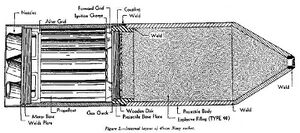Engineering:45 cm naval rocket
| 45 cm naval rocket | |
|---|---|
 Schematic of components | |
| Type | Rocket artillery |
| Place of origin | Empire of Japan |
| Service history | |
| In service | World War II |
| Used by | Imperial Japanese Navy |
| Production history | |
| Designed | 1944 |
| Specifications | |
| Length | 1.7 m (5.6 ft) |
| Shell weight | 682 kg (1,504 lb) |
| Calibre | 45 cm (18 in) |
| Carriage | Two wheeled |
| Elevation | +5° to +50° |
| Muzzle velocity | 151 m/s (495 ft/s)[1] |
| Maximum firing range | 5 km (3.1 mi) |
| Filling | Trinitroanisole |
| Filling weight | 180 kg (400 lb) |
Detonation mechanism | Nose fuze[1] |
The 45 cm naval rocket was a rocket artillery system used by garrison troops of the Imperial Japanese Navy during the late stages of World War II in defense of island bases in the Pacific.
Design
The 45 cm naval rocket was first discovered during the Battle of Luzon. It was a spin-stabilized rocket that was filled with 39 sticks of solid propellant weighing 59 kg (130 lb) and the exhaust gasses were forced through six venturis that were angled at 18° to impart spin. The total weight of the rocket motor was 258 kg (569 lb).[1]
The body of the motor, warhead and nose cone were all made from 19 mm (.75 in) rolled steel and were welded together. The warhead contained 180 kg (400 lb) of trinitroanisole and in the center of the nose cone, there was a pocket that could house either a Navy nose fuze as used by the 20 cm naval rocket or Army mortar fuze.[1]
The launcher was a two-wheeled wooden cart with a metal baseplate that held the base of the rocket. The rocket was launched by pulling a lanyard which tripped a spring powered hammer at the bottom left of the launcher which set off a percussion cap which started the rocket motor.[2] The launcher could only be used once because the force of the launch destroyed the launcher.[3]
The first captured rocket was tested in Manila and although launched successfully at a 43° angle the rocket started wobbling during the latter half of its flight and only reached a range of 2 km (1.2 mi). Four more rockets were later tested at Aberdeen Maryland proving grounds and they were able to reach 5 km (3.1 mi). The rockets created a crater 2.7 m (9 ft) deep and 6.1 m (20 ft) in diameter with flaming debris scattered up to 317 m (347 yd) from the point of impact.[3] However, the accuracy of the rocket was said to be poor so they couldn't be fired at a specific target but were instead fired towards a target and may have been more useful as a siege weapon.[1]
Gallery
References
- ↑ 1.0 1.1 1.2 1.3 1.4 German and Japanese Solid-Fuel Rocket Weapons, pg.66-68
- ↑ Japanese artillery weapons. United States Navy. Pacific Fleet and Pacific Ocean Areas.. July 1, 1945. pp. 85–86. OCLC 51837610.
- ↑ 3.0 3.1 "The Japanese Soldier in WWII - Chapter 9". http://quanonline.com/book/chapter-9/weapons-3.html#9-sec-IX-VIII2g.
 |




